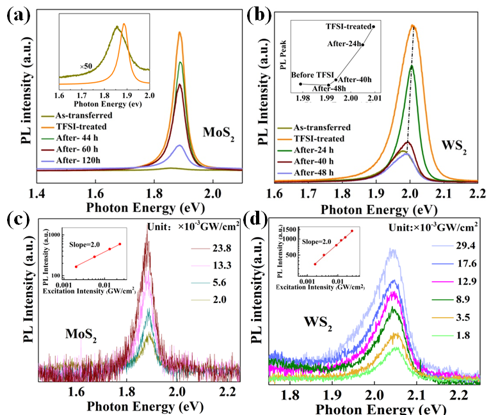Two-photon absorption (TPA) and two-photon luminescence (TPL) in two-dimensional (2D) transition metal dichalcogenides (TMDs) show great potentials in applications of optical limiting, optical signal processing, two-photon microscopy and light frequency upconversion. Defects such as edges and vacancies (eg. sulfur (S) vacancies) have been found to play a key role in determining these properties.
Recently, a study led by Prof. WANG Jun from Shanghai Institute of Optics and Fine Mechanics, Chinese Academy of Sciences, investigated the effect of bis-(trifluoromethane) sulfonimide (TFSI) treatment on the nonlinear optical properties of monolayer S-based TMDs and found that the TFSI-treated MoS2 and WS2 showed enhanced TPA and TPL performances compared to the untreated counterparts. The result was published on Optics Express.
In the experiment, monolayer MoS2 and WS2 on sapphire substrates were synthesized by CVD method and transferred to quartz substrates, and then TFSI-treated. In this process, no apparent morphological change has been observed after TFSI-treatment, and the S/Mo ratio was higher than that of the untreated one (from 1.812 ± 0.43 to 1.532 ± 0.35), suggesting that the S vacancies have been repaired.
They further investigated the steady-state PL and TPL spectra. Their study showed the PL intensity was significantly enhanced after TFSI-treatment, which is about 50 times higher than that of the as-transferred counterpart in monolayer MoS2. Similar PL enhancement was observed in monolayered WS2, which is much lower than that in MoS2 as the low defect density in WS2. More importantly, TPL has been realized in these two materials with the excitation of 1030 nm fs laser pulse at room temperature; previously, however, only low-temperature TPL had been reported for monolayer WS2 at a low temperature of 10 K.
The influences of TFSI treatment on the TPA properties and dynamics of carrier recombination have been studied through micro I-scan system and nondegenerate ultrafast optical pump-probe technology. They found the TPA coefficient has a great enhancement both in MoS2 and WS2.
This work shed light on how the defects tailor the nonlinear absorption and luminescence propertied of S-based TMDs, which is of great importance for their nonlinear optical applications.
This work was supported by the Chinese National Natural Science Foundation, the Strategic Priority Research Program of CAS, the Key Research Program of Frontier Science of CAS, and the Program of Shanghai Academic Research Leader.

Fig. 1 PL and TPL spectra for monolayer MoS2 and WS2before and after the TFSI treatment. (image by SIOM)
Related website:
https://www.osapublishing.org/oe/abstract.cfm?uri=oe-27-10-13744
Contact:
Mr. Cao Yong
General Administrative Office
Shanghai Institute of Optics and Fine Mechanics, CAS
Email: caoyong@siom.ac.cn
Home | About SIOM | Newsroom | International | Admissions | Publications | Contact
@ Shanghai Institute of Optics and Fine Mechanics Tel:02169918000 沪ICP备05015387号-1 Technical support:Qingyun Software